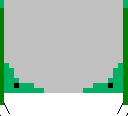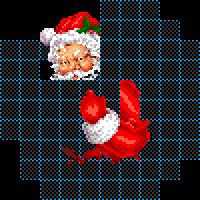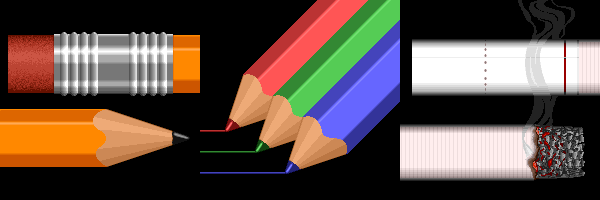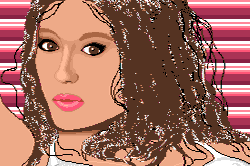My Early 2D Stuff
Everybody has to start somewhere. Assembling the material for this page was like uncorking a time capsule. All of it was done on the original Amiga, the A1000, in 1986 and 1987, using Deluxe Paint, AmigaBASIC, and Workbench 1.1 and 1.2.

Color Cycling
Back when computer memories were measured in Ks rather than Ms or Gs, an economical way to produce animation was to cycle the color palette. The pixel data, an array of indexes into a color lookup table, doesn't change at all. The colors in the table are cycled to create the illusion of motion.

 |
 |
|||||
 |
||||||
Program Driven
While playing around with random dissolves and animated effects, I wrote an AmigaBASIC program to create this frog. He appeared on the screen one random block at a time, then his eye and mouth sequences were played at random intervals. I used the Amiga's built-in text-to-speech facility to give him a good croak. The random feel is recreated here by making the frame rates of the parts relatively prime, but in the original, he could go for a long time without croaking, which gave the animation an element of suspense.

Yeah, I know
My wife thought he was cute. This, of course, is Unilever's fabric softener bear.

Antialiasing
Note the difference between the two small blue stars in the lower left. One exhibits aliasing, a jagged stairstep effect caused by undersampling. The edges of the other one have been blurred in a precise way that, while not eliminating the sampling error, spreads it around so that it's much less objectionable to the eye. I antialiased a number of my early images by hand, one pixel at a time. The antialiased drawing tools everyone now takes for granted didn't exist.

Cross Stitch
For a time, I experimented with using needlepoint and cross stitch patterns to paint images, sort of a digital paint-by-numbers. The patterns seemed ideal for this, since they were already laid out on a grid and used a relatively small palette. The results were often excellent, but they're unoriginal, of course, and the work is incredibly tedious, with none of the salutary meditative benefits of doing real needlepoint.
I considered doing this in reverse, turning original digital images into needlepoint patterns, but I never actually tried it.

IBM PC XT
If you remember when every computer looked like this, you're at least
as old as I am. Compared to current machines, the CPUs were thousands of
times slower and the fixed drives nearly a million times smaller. Their
12-inch screens supported 16 colors, and their speakers supported sounds
like beep
and click.
An XT cost $5000 in 1985 (more than
$12,000 in today's dollars).
I painted this for my father-in-law. CAAPS was a process simulation program he wrote for his chemical engineering students.
My Cylindrical Object
Period


Hidden Grid
This image was based on a photograph. To get the proportions right, I transcribed the outlines using a grid technique sometimes taught to beginning art students. (Remarkably, there's now at least one company with a line of art products designed for this approach.)
